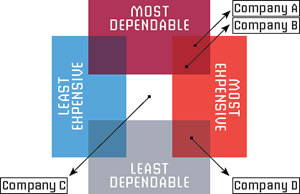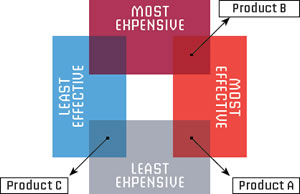What's In Your Janitorial Closet?
- By Michael Wilson
- 04/01/16
Advertisers and others in the marketing
industry are very keen on something called
composite product mapping (CPM), also referred
to as “product mapping.” The essence of CPM is
to find out what consumers think about products such as
toothpaste, lawn mowers or frozen dinners.
But it is not just for business-to-consumer. Business-to-business
organizations can also use CPM to learn what their
customers think about their tractors, road graders and Internet
services. Further, colleges and universities can use a form
of CPM, along with other procurement tools, to help select the
best and most cost-effective products for their facilities.
Let’s use the example of an Internet service provider to
illustrate how CPM works. Say that Internet service “A” is in
a market competing with three other service providers. They
want to know what consumers think about their service,
specifically as to reliability and cost, compared to three other
companies, which we will call Company “B,” “C” and “D.”
They turn to a marketing company which surveys 500
consumers that have had experience with all four Internet
providers and generates a visual map of those responses.
The top of the map is labeled Most Dependable, the bottom
Least Dependable. The left side of the map is labeled Least
Expensive, the right side Most Expensive.

Based on the consumer answers, this is what the map
reveals:
- Company B is at the top of the map, indicating it is most
dependable, and also leans to the right, because it is more
expensive than the other services.
- Company C is pretty much in the middle of the map; its
charges, according to the consumers, are not too high or
too low and their service is viewed as acceptable.
- Company D takes the “Least Dependable” slot, with a
position towards the bottom of the map, and interestingly,
it is also viewed as moderately expensive, so it is over to
the right-hand side of the map.
- According to consumers, Company A is viewed as having
better than average service, giving it a higher position on
the map, but is furthest to the right indicating consumers
find it to be the most expensive of all the brands.
What we see with this very simple example is that CPM
can be very helpful to condense a large and potentially
confusing mass of data into a meaningful picture.
APPLYING CPM TO YOUR JANITORIAL CLOSET
So now that you have an idea how CPM works, let’s apply it to
a key expense that all colleges and universities have in common:
the selection of janitorial-related goods from cleaning solutions
and equipment to all kinds of paper products. But this time, we
are going to ask custodial workers and administrators involved in
campus housekeeping to evaluate the many products they use for
cleaning as to the costs and effectiveness of these products. Later,
we can also look into issues such as ease of use, durability (if applicable),
environmental factors and so on.
Once again we build a map. We have decided to evaluate
perhaps five different all-purpose cleaners used on the campus.
The top of the map is labeled Most Expensive, the bottom Least
Expensive; the left-hand side is labeled Least Effective and the
right Most Effective. Based on the responses from our custodial
staff and administrators, we start building our map.
 Some startling things begin to emerge:
Some startling things begin to emerge:
- The most effective products are not the most costly (Product A).
- The most costly products are actually some of the most effective
(Product B).
- Some products are not considered costly but they aren’t considered
effective; yet they are still being purchased (Product C).
With product evaluations mapped, custodial workers and college
administrators often can easily see which all-purpose product
is giving them “the most bang for the buck.” They can eliminate
the others, which often turns into a cost savings. Plus, ordering
larger quantities of fewer products may allow the university to
receive discounts from manufacturers or their distributors. Additionally,
it can help reduce clerical time spent processing invoices
from several vendors.
WHAT IF NOTHING PASSES THE CPM TEST?
It’s always hoped that once a product-mapping program has
been completed that one or two products take the honors… but
not always. When this happens, the good thing is that the institution
can stop selecting products that are simply not making the
grade. The bad thing is that
they must begin searching for
a product or products that do
meet their needs.
However, their investigation
can become stymied from the
start. For instance, in North
America, approximately 245 chemical manufacturers make 245 —
and likely far more — different floor finishes, as an example. Some of
the questions that arise in a situation like this include the following:
- How can we narrow our options down to just those that are
green-certified?
- How do we determine which would work best on our floors?
- Which is most cost effective?
- Which has proven to be the most durable?
- Which provides the type of shine we want for our floors?
Important questions, but they are not easy for the customer
to answer. Fortunately, new technologies, software programs and
even free online “dashboard” systems are available for administrators
to help make the selection process easier.
The ways these different systems work can vary. Some use a
question-and-answer format, allowing administrators to answer
questions to better determine the school’s needs. These technologies
are not necessarily designed to replace the janitorial distributor.
In fact, they are often available from distributors and encourage
administrators to meet with distributors to further analyze
their options, enabling them to eliminate trial and error and make
fact-based decisions.
While our focus here has been on janitorial products, CPM can
be applied to a whole range of products, and even services. With so
many manufacturers now making so many similar products used
for the same or similar purpose, it has become virtually impossible
for administrators to determine which products will work best in
their facilities.
It may take a little time to implement a CPM program, but it
can be time well worth it because of the potential savings. In many
cases, these techniques including the technologies just discussed,
allow administrators for the first time to actually recognize the
breadth of products they are purchasing and, even more important,
which ones they should be purchasing. Ultimately, these
techniques are simply good business practices all college and
university administrators should adhere to.
This article originally appeared in the issue of .